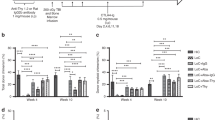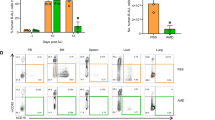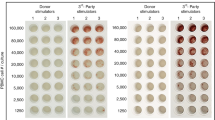Abstract
Because of the toxicity associated with myeloablative conditioning, nonmyeloablative regimens are increasingly being used in vulnerable patient populations. For patients with sickle cell disease, stable mixed chimerism has proven sufficient to reverse the phenotype. Because the vast majority of patients do not have an HLA-matched sibling, a safe nonmyeloablative regimen that could be applied to the haploidentical setting would be ideal. We employed a mismatched mouse model using BALB/c donors and C57BL/6 recipients. Recipient mice were conditioned with 200 cGy TBI and sirolimus or CSA with or without post transplant Cy (PT-Cy). Our data show that when sirolimus or PT-Cy alone is given to C57BL/6 recipients, donor cells are not detected. However, when sirolimus is administered for 15 or 31 days starting 1 day before or up to 6 days after transplant with PT-Cy, all mice maintain stable mixed chimerism. In contrast, conventional therapy employing CSA with or without PT-Cy does not result in stable mixed chimerism. Lastly, mice with stable mixed chimerism after sirolimus display decreased reactivity to donor Ag both in vitro and in vivo. These data identify a novel strategy for inducing mixed chimerism for the treatment of nonmalignant hematologic diseases.
This is a preview of subscription content, access via your institution
Access options
Subscribe to this journal
Receive 12 print issues and online access
$259.00 per year
only $21.58 per issue
Buy this article
- Purchase on Springer Link
- Instant access to full article PDF
Prices may be subject to local taxes which are calculated during checkout



Similar content being viewed by others
References
Bernaudin F, Socie G, Kuentz M, Chevret S, Duval M, Bertrand Y et al. Long-term results of related myeloablative stem-cell transplantation to cure sickle cell disease. Blood 2007; 110: 2749–2756.
Vermylen C, Cornu G, Ferster A, Brichard B, Ninane J, Ferrant A et al. Haematopoietic stem cell transplantation for sickle cell anaemia: the first 50 patients transplanted in Belgium. Bone Marrow Transplant 1998; 22: 1–6.
Walters MC, Patience M, Leisenring W, Eckman JR, Scott JP, Mentzer WC et al. Bone marrow transplantation for sickle cell disease. N Engl J Med 1996; 335: 369–376.
Walters MC, Patience M, Leisenring W, Rogers ZR, Aquino VM, Buchanan GR et al. Stable mixed hematopoietic chimerism after bone marrow transplantation for sickle cell anemia. Biol Blood Marrow Transplant 2001; 7: 665–673.
Hsieh MM, Kang EM, Fitzhugh CD, Link MB, Bolan CD, Kurlander R et al. Allogeneic hematopoietic stem-cell transplantation for sickle cell disease. N Engl J Med 2009; 361: 2309–2317.
Hsieh MM, Fitzhugh CD, Tisdale JF . Allogeneic hematopoietic stem cell transplantation for sickle cell disease: the time is now. Blood 2011; 118: 1197–1207.
Durakovic N, Radojcic V, Powell J, Luznik L . Rapamycin promotes emergence of IL-10-secreting donor lymphocyte infusion-derived T cells without compromising their graft-versus-leukemia reactivity. Transplantation 2007; 83: 631–640.
Turnquist HR, Raimondi G, Zahorchak AF, Fischer RT, Wang Z, Thomson AW . Rapamycin-conditioned dendritic cells are poor stimulators of allogeneic CD4+ T cells, but enrich for antigen-specific Foxp3+ T regulatory cells and promote organ transplant tolerance. J Immunol 2007; 178: 7018–7031.
Powell JD, Lerner CG, Schwartz RH . Inhibition of cell cycle progression by rapamycin induces T cell clonal anergy even in the presence of costimulation. J Immunol 1999; 162: 2775–2784.
Baan CC, van der Mast BJ, Klepper M, Mol WM, Peeters AM, Korevaar SS et al. Differential effect of calcineurin inhibitors, anti-CD25 antibodies and rapamycin on the induction of FOXP3 in human T cells. Transplantation 2005; 80: 110–117.
Powell JD, Fitzhugh C, Kang EM, Hsieh M, Schwartz RH, Tisdale JF . Low-dose radiation plus rapamycin promotes long-term bone marrow chimerism. Transplantation 2005; 80: 1541–1545.
Jager MD, Liu JY, Timrott KF, Popp FC, Stoeltzing O, Lang SA et al. Sirolimus promotes tolerance for donor and recipient antigens after MHC class II disparate bone marrow transplantation in rats. Exp Hematol 2007; 35: 164–170.
Xu H, Zhu Z, Huang Y, Bozulic LD, Hussain LR, Yan J et al. Innate and adaptive immune responses are tolerized in chimeras prepared with nonmyeloablative conditioning. Transplantation 2012; 93: 469–476.
Kean LS, Adams AB, Strobert E, Hendrix R, Gangappa S, Jones TR et al. Induction of chimerism in rhesus macaques through stem cell transplant and costimulation blockade-based immunosuppression. Am J Transplant 2007; 7: 320–335.
Luznik L, Jones RJ, Fuchs EJ . High-dose cyclophosphamide for graft-versus-host disease prevention. Curr Opin Hematol 2010; 17: 493–499.
Luznik L, O’Donnell PV, Symons HJ, Chen AR, Leffell MS, Zahurak M et al. HLA-haploidentical bone marrow transplantation for hematologic malignancies using nonmyeloablative conditioning and high-dose, posttransplantation cyclophosphamide. Biol Blood Marrow Transplant 2008; 14: 641–650.
Brodsky RA, Luznik L, Bolanos-Meade J, Leffell MS, Jones RJ, Fuchs EJ . Reduced intensity HLA-haploidentical BMT with post transplantation cyclophosphamide in nonmalignant hematologic diseases. Bone Marrow Transplant 2008; 42: 523–527.
Luznik L, Jalla S, Engstrom LW, Iannone R, Fuchs EJ . Durable engraftment of major histocompatibility complex-incompatible cells after nonmyeloablative conditioning with fludarabine, low-dose total body irradiation, and posttransplantation cyclophosphamide. Blood 2001; 98: 3456–3464.
Colson YL, Wren SM, Schuchert MJ, Patrene KD, Johnson PC, Boggs SS et al. A nonlethal conditioning approach to achieve durable multilineage mixed chimerism and tolerance across major, minor, and hematopoietic histocompatibility barriers. J Immunol 1995; 155: 4179–4188.
Colson YL, Li H, Boggs SS, Patrene KD, Johnson PC, Ildstad ST . Durable mixed allogeneic chimerism and tolerance by a nonlethal radiation-based cytoreductive approach. J Immunol 1996; 157: 2820–2829.
Luznik L, Engstrom LW, Iannone R, Fuchs EJ . Posttransplantation cyclophosphamide facilitates engraftment of major histocompatibility complex-identical allogeneic marrow in mice conditioned with low-dose total body irradiation. Biol Blood Marrow Transplant 2002; 8: 131–138.
Mayumi H, Umesue M, Nomoto K . Cyclophosphamide-induced immunological tolerance: an overview. Immunobiology 1996; 195: 129–139.
Mayumi H, Himeno K, Tanaka K, Tokuda N, Fan JL, Nomoto K . Drug-induced tolerance to allografts in mice. XII. The relationships between tolerance, chimerism, and graft-versus-host disease. Transplantation 1987; 44: 286–290.
Podder H, Stepkowski SM, Napoli KL, Clark J, Verani RR, Chou TC et al. Pharmacokinetic interactions augment toxicities of sirolimus/cyclosporine combinations. J Am Soc Nephrol 2001; 12: 1059–1071.
Patel SJ, Elliott EN, Knight RJ, Gaber LW, Gaber AO . Considerations in sirolimus use in the early and late post-transplant periods. Expert opinion on drug safety 2009; 8: 421–434.
Brook NR, Waller JR, Bicknell GR, Nicholson ML . Cyclosporine and rapamycin act in a synergistic and dose-dependent manner in a model of immunosuppressant-induced kidney damage. Transplant Proc 2005; 37: 837–838.
Gao W, Lu Y, El Essawy B, Oukka M, Kuchroo VK, Strom TB . Contrasting effects of cyclosporine and rapamycin in de novo generation of alloantigen-specific regulatory T cells. Am J Transplant 2007; 7: 1722–1732.
Coenen JJ, Koenen HJ, van Rijssen E, Kasran A, Boon L, Hilbrands LB et al. Rapamycin, not cyclosporine, permits thymic generation and peripheral preservation of CD4+ CD25+ FoxP3+ T cells. Bone Marrow Transplant 2007; 39: 537–545.
Blazar BR, Taylor PA, Sehgal SN, Vallera DA . Rapamycin, a potent inhibitor of T-cell function, prevents graft rejection in murine recipients of allogeneic T-cell-depleted donor marrow. Blood 1994; 83: 600–609.
Blazar BR, Taylor PA, Snover DC, Sehgal SN, Vallera DA . Murine recipients of fully mismatched donor marrow are protected from lethal graft-versus-host disease by the in vivo administration of rapamycin but develop an autoimmune-like syndrome. J Immunol 1993; 151: 5726–5741.
Blazar BR, Taylor PA, Panoskaltsis-Mortari A, Sehgal S, Vallera DA . In vivo inhibition of cytokine responsiveness and graft-versus-host disease mortality by rapamycin leads to a clinical–pathological syndrome discrete from that observed with cyclosporin A. Blood 1996; 87: 4001–4009.
Delgoffe GM, Kole TP, Zheng Y, Zarek PE, Matthews KL, Xiao B et al. The mTOR kinase differentially regulates effector and regulatory T cell lineage commitment. Immunity 2009; 30: 832–844.
Battaglia M, Stabilini A, Roncarolo MG . Rapamycin selectively expands CD4+CD25+FoxP3+ regulatory T cells. Blood 2005; 105: 4743–4748.
Qu Y, Zhang B, Zhao L, Liu G, Ma H, Rao E et al. The effect of immunosuppressive drug rapamycin on regulatory CD4+CD25+Foxp3+T cells in mice. Transpl. Immunol 2007; 17: 153–161.
Taylor PA, Lees CJ, Blazar BR . The infusion of ex vivo activated and expanded CD4(+)CD25(+) immune regulatory cells inhibits graft-versus-host disease lethality. Blood 2002; 99: 3493–3499.
Pilat N, Klaus C, Gattringer M, Jaeckel E, Wrba F, Golshayan D et al. Therapeutic efficacy of polyclonal tregs does not require rapamycin in a low-dose irradiation bone marrow transplantation model. Transplantation 2011; 92: 280–288.
Hale DA, Gottschalk R, Fukuzaki T, Wood ML, Maki T, Monaco AP . Extended skin allo- and xenograft survival in mice treated with rapamycin, antilymphocyte serum, and donor-specific bone marrow transfusion. Transplant Proc 1996; 28: 3269.
Hale DA, Gottschalk R, Fukuzaki T, Wood ML, Maki T, Monaco AP . Superiority of sirolimus (rapamycin) over cyclosporine in augmenting allograft and xenograft survival in mice treated with antilymphocyte serum and donor-specific bone marrow. Transplantation 1997; 63: 359–364.
Hale DA, Gottschalk R, Umemura A, Maki T, Monaco AP . Establishment of stable multilineage hematopoietic chimerism and donor- specific tolerance without irradiation. Transplantation 2000; 69: 1242–1251.
Prigozhina TB, Elkin G, Khitrin S, Slavin S . Prevention of acute graft-vs-host disease by a single low-dose cyclophosphamide injection following allogeneic bone marrow transplantation. Exp Hematol 2008; 36: 1750–1759.
Raiola AM, Dominietto A, Ghiso A, Di Grazia C, Lamparelli T, Gualandi F et al. Unmanipulated haploidentical bone marrow transplantation and posttransplantation cyclophosphamide for hematologic malignancies after myeloablative conditioning. Biol Blood Marrow Transplant 2013; 19: 117–122.
Caballero-Velazquez T, Sanchez-Abarca LI, Gutierrez-Cosio S, Blanco B, Calderon C, Herrero C et al. The novel combination of sirolimus and bortezomib prevents graft-versus-host disease but maintains the graft-versus-leukemia effect after allogeneic transplantation. Haematologica 2012; 97: 1329–1337.
Acknowledgements
We thank Deborah Simon, Alex Agoreyo, Celinia Ondeck, Assefa Davis and all other Building 10A staff at the NIH for animal caretaking and procedural support, and Dr Alan Remaley for laboratory support.
Author contributions: CF, RW, MH, LL, JP and JT designed the study, wrote the manuscript and reviewed all data. CF, RW, MH, OP and CM performed study procedures and analyses. OP and CM reviewed the manuscript.
Author information
Authors and Affiliations
Corresponding author
Ethics declarations
Competing interests
The authors declare no conflict of interest.
Additional information
Supplementary Information accompanies this paper on Bone Marrow Transplantation website
Supplementary information
Rights and permissions
About this article
Cite this article
Fitzhugh, C., Weitzel, R., Hsieh, M. et al. Sirolimus and post transplant Cy synergistically maintain mixed chimerism in a mismatched murine model. Bone Marrow Transplant 48, 1335–1341 (2013). https://doi.org/10.1038/bmt.2013.60
Received:
Revised:
Accepted:
Published:
Issue Date:
DOI: https://doi.org/10.1038/bmt.2013.60
Keywords
This article is cited by
-
Low dose post-transplant cyclophosphamide and sirolimus induce mixed chimerism with CTLA4-Ig or lymphocyte depletion in an MHC-mismatched murine allotransplantation model
Bone Marrow Transplantation (2024)
-
Pre-transplant sirolimus might improve the outcome of haploidentical peripheral blood stem cell transplantation with post-transplant cyclophosphamide for patients with severe aplastic anemia
Bone Marrow Transplantation (2015)
-
Haploidentical SCT: the mechanisms underlying the crossing of HLA barriers
Bone Marrow Transplantation (2014)



